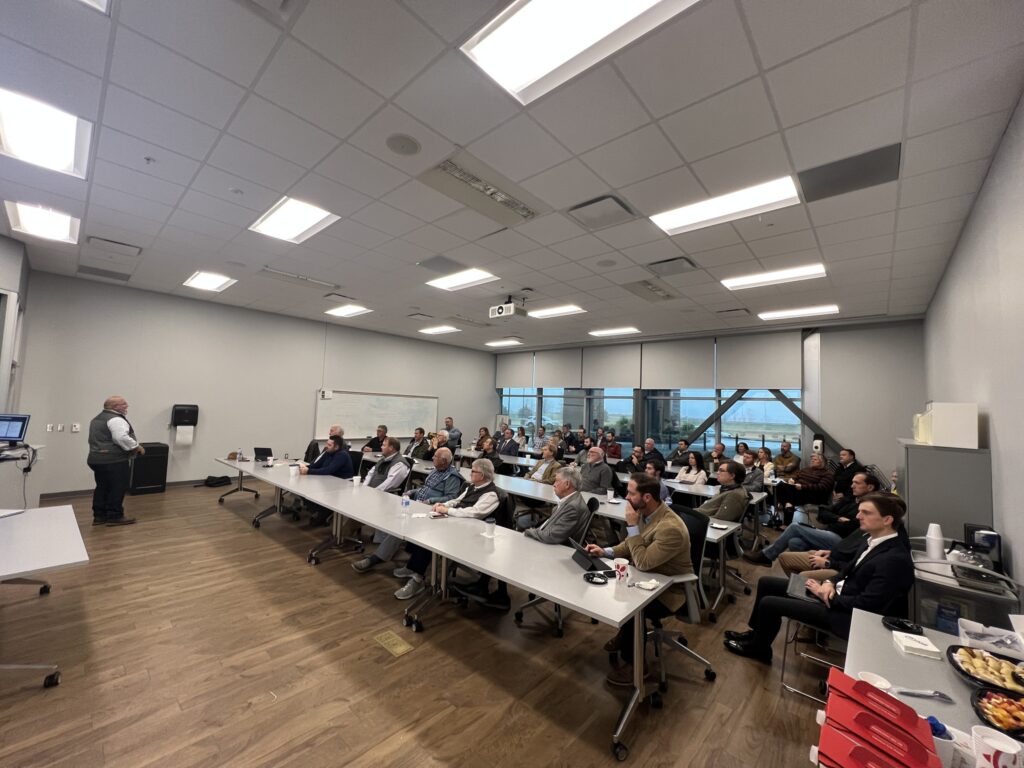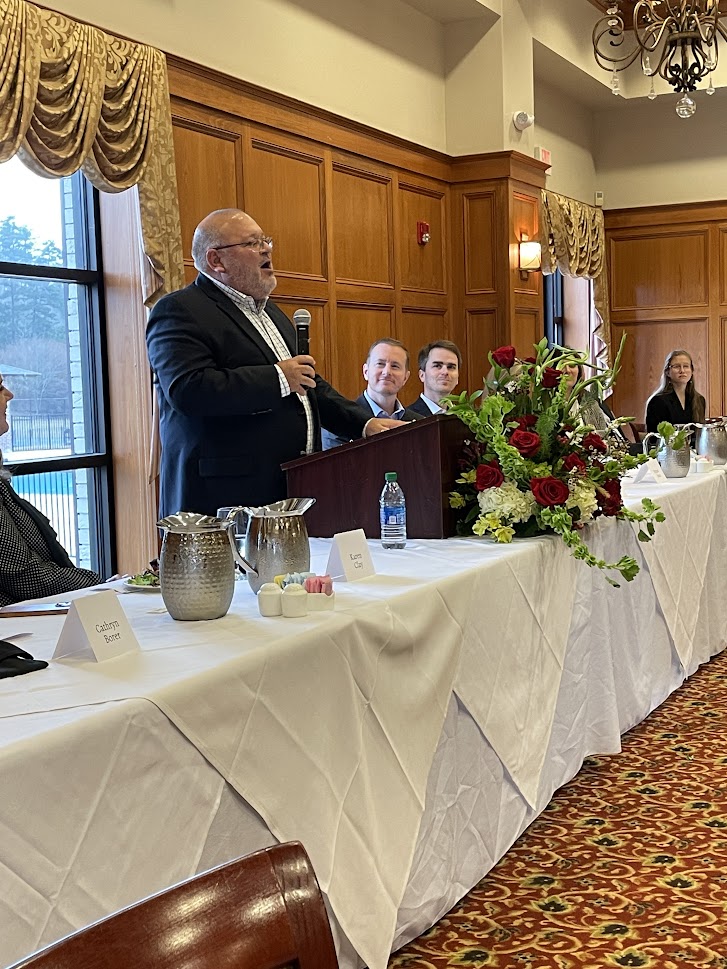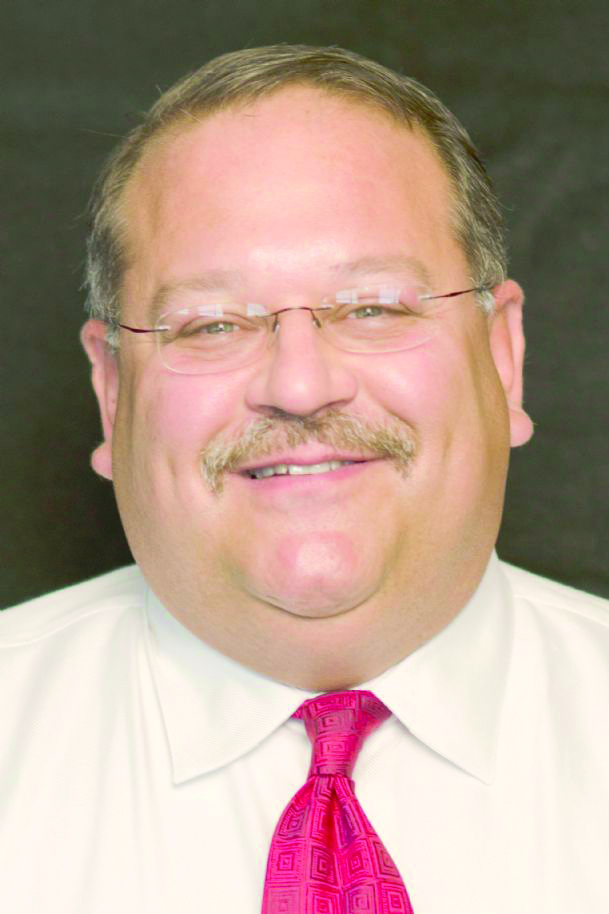Moving economic development forward through the Golden Triangle LINK
Around the South, Joe Max Higgins is known as a rock star in economic development circles.
But Higgins wasn’t always well received.
In early 2003, Higgins had a plum job in his hometown of Paragould, Ark., and was finishing up tongue-and-groove flooring and had added two new air conditioning units to his family home when a headhunter called.
“I was running a chamber and economic development office, where we were a top five deal producer in the Mid-South region,” recalled Higgins. “I mean, we were on the map!”
At first glance, Higgins wasn’t interested in the chamber/economic developer job at the Columbus Lowndes Economic Development Association (CLEDA), as it was known then, but after delving into details, he changed his mind. He arrived in Columbus in June, when Charleigh Ford Jr. was the chief economic developer through October. Ford was a laid-back, well-liked good ole boy, who wasn’t necessarily a deal closer. Higgins came in with a hard-charging aggressive manner. The change didn’t sit well with some folks.
“When I went home for Christmas that year, a banker, an elected official, and an airport official tried to have me fired,” Higgins recalled, with a laugh. “They went to the executive committee and said, ‘he’s not like us. He doesn’t fit in. We don’t like his style. Y’all need to fire him.’ Fortunately, my executive committee at the time said, ‘we’re going to stick with him and see how it works.’ I thought I was only going to stay two or three years. I’ve been here 21 years and just signed a new contract.”
An Impressive Portfolio
During Higgins’ tenure, the Golden Triangle Development LINK (gtlink.org), which now represents Clay, Lowndes, and Oktibbeha counties, has generated more than $10 billion in capital investments and created more than 10,000 jobs.
In 2022, The LINK announced then the largest economic development deal in state history: Steel Dynamics’ investment of $2.5 billion by expanding its Columbus campus, located on a TVA megasite, and creating 1,000 jobs, with an average salary of $93,000.
The LINK created East Mississippi Community College’s Communiversity, a $42 million high-tech training facility, aka the Center for Manufacturing Technology Excellence. Higgins is working on a fifth megasite, Cinco Megasite, a 1,500-acre greenfield site with visibility from U.S. Highway 82. And the Golden Triangle Regional Airport recently became home to the state’s first electric aviation charger, through partnerships with BETA Technologies and Avflight.
“You enlist people, sell them on the vision, and they become team members with you and make it their job to see the project succeed,” said Higgins, of the secret of The LINK’s accomplishments, pointing to Brenda Latham, who served as his long-time right-hand assistant.


Hitting the Big Time
Soon after Higgins arrived in Columbus, TVA unveiled its megasite program.
“Everybody in the south was chasing car plants,” he recalled. “TVA went on a national search and hired McCallum Sweeney, a site selection company that had been instrumental in working the Nissan project, to write the criteria, judge and certify those sites. I’ll bet there were 500 people at the unveiling of the megasite program in Nashville.
“They said, ‘first, you’ve got to have 1,500 acres and 1,000 of it must be developable. You’ve got to have a railroad, we prefer two, and we prefer them to be Class 1s (freight railroad companies that earn more than $943.9 in revenue annually). And you’ve got to have x water and x sewer and x electricity … and you’ve got to be within 50 miles from a commercial airport.’”
Higgins grew excited.
“We’ve got all that,” he said. “The guy to the left of me was from Tallahatchie County and he said, ‘we’re done.’ The guys to the right of me were from central Tennessee. They said, ‘we’re out.’ I went down and stood second in line and told them I needed two numbers. They said, ‘each site just needs one number.’ And I said, ‘yeah, I’ve got two sites.’ Everyone around me started laughing and the room got quiet. Nobody spoke to me leaving. I got in my car, called Brenda, and talked to her all the way to Columbus. We had six weeks to get a whole lot of work done. I needed all the landowners in the office the next morning at nine o’clock.”
In 2004, TVA certified the first megasite in Lowndes County.
“In October, Steelcorr (now Steel Dynamics) walked in the door,” said Higgins.
In 2006, TVA certified the second megasite in Lowndes County.
“Then we did a third megasite, in West Point, the Prairie Belt Power site,” he said. “And that’s where we landed Yokohama (Tire Company).”
A fourth megasite, the Infinity Megasite, was developed in Lowndes County.
And the fifth: “Cinco” is being developed in the western part of the county.
“I was told our Cinco Megasite is by far our most superior site yet,” said Higgins. “Somebody asked, ‘well, are you guaranteeing us that we’ll get another big deal?’ I said absolutely not. What I’m telling you is that we’ve been successful beyond anybody’s imagination at all four megasites. And if this one isn’t successful, I’ll quit and leave my career batting .800 on megasites. And that’s still pretty damn good.”
The Story of the Communiversity
Another turning point occurred in the mid-teens: workforce development and education had become an Achille’s heel. That’s when the idea of the Communiversity took root. But it was going to cost at least $38 million to construct.
“We brought in Bill Fruth—he does measurements of strength of economies—and we said, ‘we want you to do a roadmap for these three counties,’” said Higgins. “He said workforce development/education was going to be more important moving forward toward better, newer and more advanced jobs, and we needed a cutting-edge deal.
“Mack Portera, who had been president of Mississippi State University and chancellor of the University of Alabama system, was working as a consultant for us, and he concurred we needed to increase our efforts on workforce. We had an industrial training facility at the community college branch campus at Mayhew, but it was very small, maybe three or four bays. They had to take equipment in and out, and it was disruptive. As a team, we came up with the idea of building something that wasn’t like anywhere in the world, that when you walked in the door, you knew it was a game changer.”
Higgins sent Portera and Reed Nelson, a consultant, to meet with then Lt. Gov. Tate Reeves to ask for $38 million for the project.
“Tate promptly said, ‘get the hell out of my office,’” recalled Higgins, chuckling. “He said, ‘if I give y’all that, every community college in Mississippi is going to want the same thing. There’s no way. It ain’t gonna happen. Now get out of here.’ When Reed grabbed the door, he looked at Tate and said, ‘well, if you won’t give us $38 million, how much will you give us?’ Tate said $8 million. They bebopped into my office, sat down, and said good news! We got $8 million! I said, what?! Guys, we’re $30 million short!”
Higgins called in county supervisors from the tri-county area and asked for $13.5 million—$10 million from Lowndes County, $2.5 million from Oktibbeha County, and $1 million from Clay County.
Portera and Nelson returned to Reeves’ office with three binding resolutions totaling $13.5 million. Reeves pledged another $10 million.
“Now we’re getting there,” said Higgins. “At the same time, we were working with our friend, Alan Nunnelee (a former U.S. representative and state senator), who grew up in Columbus. Alan was working on getting the balance of $6.5 million when he got sick and died. So, we called (the late Sen. Thad) Cochran’s office and said, ‘we got a problem. Alan was real close, but he’s not able to carry the banner anymore.’ And Cochran got it funded (through the Appalachian Regional Commission) and under a continuing resolution, we got $4 million more. Reed was the behind-the-scenes pusher guy. It wouldn’t have happened without him.”
The Communiversity, located at the gateway of the Golden Triangle Industrial Park, is impressive. Opened in 2017, the 145,638-square-foot facility features sweeping, curved lines and a vast border of glass on its exterior, with significant open space inside for local industries to display their products. Training takes place in 21 high-bay laboratories designed for easy access for setup and removal of heavy machinery used by area manufacturers. Courses include electrical technology; mechatronics technology; engineering, drafting and design; precision manufacturing and machining; systems-based automation; and industrial maintenance.
Understanding the Employment Numbers
In May 2024, the U.S. average unemployment rate was 3.7%. The Mississippi average was 2.9%. Lowndes County sat at 3%, Oktibbeha County was 2.8%, and Clay County was 3.7%.
“Now that doesn’t tell you the whole story because the workforce in the Golden Triangle comes from 37 counties in two states,” said Higgins. “For example, the steel mill works about 950 people. Of those, 111 reside in Monroe County (north of Lowndes County). That’s not an insignificant number. Some manufacturer employees work four days on, four days off, and we’ve seen workers come in with travel trailers, set it up here while they’re working, and go back home when they’re off. Also, I’ve deduced that in Mississippi, people are tied to their land. It’s probably four or five years (of employment) before those workers have a meaningful talk about moving.”
Pay is underestimated, Higgins said.
“When we announced the aluminum mill, the CEO of Steel Dynamics got up there and said the average pay in Columbus (in 2021) was $120,000. But wait, it gets better. Last year, they paid 45% of wages in profit sharing. So, $120,000 plus 45% of that in profit sharing. They give you stock, they give you insurance, all of that. And if you’ve got one or 16 kids, they give you $5,000 a child to send them to college,” said Higgins.
Higgins, who has a staff of six, recently inked long-term contracts with Clay and Oktibbeha counties at $500,000 annually each, with a $1.5 million buyout. A private booster club in Columbus contributes $450,000 annually.
This year, The LINK worked out a deal with the Convention and Visitors Bureau (CVB) to spin off the chamber of commerce, freeing up Higgins to focus solely on economic development. Higgins’ office helped the CVB hire a new director.
Looking Ahead
The LINK’s goals 2023-2028 include constructing a new regional economic development office at the Golden Triangle Regional Airport. Work on it began July 22.
Goals include constructing and equipping a new fire station and a new ambulance station for the Golden Triangle Industrial Park. Groundbreaking at the new fire station should take place this month.
“We’re working with the University of Mississippi Medical Center to not only have air ambulance, but also wheeled ambulance,” said Higgins. “I met with the airport director (in mid- July), and we’re still trying to figure out the best way to do it.”
The LINK plans to develop an onsite, in-park daycare and amend by-laws to add three trust members to the executive committee with the assumption that a $350,000 annual contribution is met. On July 23, by-law recommendation changes were submitted to the executive committee.
As for plans to retire, Higgins, 63, teased: “I might think about it in five years.”
Higgins’s family—his wife, Tammy, also an Arkansas native, and their daughter, Hannah—have remained his biggest cheerleaders.
“When I do retire, we’ll have a team ready,” he said.


